In real life, we are fascinated with numbers and counting numbers. Suppose you wrote 5 letters, and the letters are put into 5 different envelopes. But one of them will be faulty, i.e., the letter might not be in the correct envelope, and as a result, the letter will not reach the intended person. Can you guess in how many ways the correct letter can be put into the wrong envelope? This is where the concept of permutation and combination comes in. Basically, we are counting numerous ways through which this problem can be solved.
| There are two basic principles of counting, and they are
The fundamental principle of counting: Let the event X occur in n different ways and another event Y occurs in m different ways. The total number of occurrences of two events is m x n. The addition principle: Let the event X occur in m different ways and event Y occurs in n different ways, and both events cannot occur together, so the occurrence of events X or Y is m + n. |
What Is Permutation in Maths?
A permutation means a number of objects arranged in a definite order by taking some numbers or all numbers at one time.
When all objects are distinct, we arrange the numbers by
| The permutation value by taking r objects out of n objects at a time will be represented by
n(n -1)(n – 2)(n – 3)………….(n – r + 1), which is written as nPr, which can also be written as \(\begin{array}{l}\frac{n!}{(n-r)!}\end{array} \)
Thus, \(\begin{array}{l}^nP_0 = \frac{n!}{(n-0)!}=\frac{n!}{n!} = 1\end{array} \)
\(\begin{array}{l}^nP_n = \frac{n!}{(n-n)!}=\frac{0!}{0!} = 1\end{array} \)
So, permutation is the same as counting some numbers by keeping other numbers constant. |
When all objects are not distinct
| Suppose we have the word MADAM. If we do the permutation of the word, we will get
\(\begin{array}{l}\frac{5!}{2!} = \frac{120}{4} = 30\end{array} \)
Because we can see that the first letter ‘M’ and the first letter ‘A’ are the same as that of the second letter ‘M’ and ‘A’. |
When out of n objects, r objects are the same, the rest are different
| The permutation in such case will be given by \(\begin{array}{l}\frac{n!}{p!}\end{array} \) |
When out of n objects, k1 objects are of the same kind, k2 objects are of another kind, k3 objects are of another kind…ka is of a-th kinds, then
| The permutation will be given by
\(\begin{array}{l}\frac{n!}{k_1! \times k_2! \times k_3! \times …. \times k_a! }\end{array} \) |
Circular Permutations

Permutation with Repetition
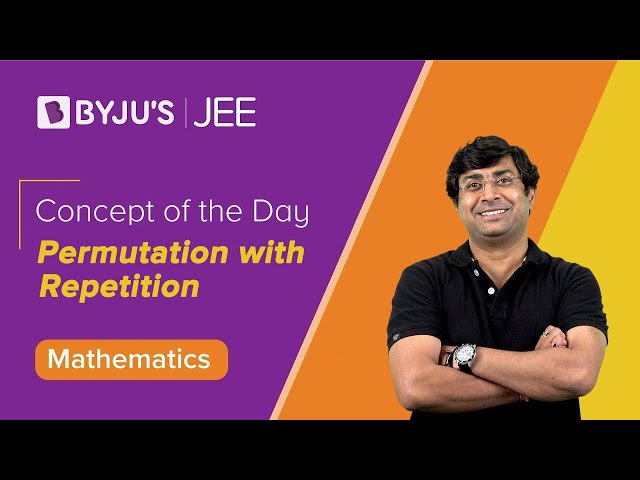
What Is Combination in Maths?
Selection of objects from a group of objects where the order of selection does not matter.
Selection of r objects from n objects is given by
Formulas for Combinations

Restricted Combination

Solved Examples of Permutation and Combination
Example 1:
How many numbers greater than 2000 but less than 5000 can be formed by digits 0,1,2,3,4,5,6 and 7 with a) repetition and b) without repetition?
Solution:
In the first place, with repetition, we can arrange the number as 2, 3 and 4 only.
The other three places can be filled in 8 x 8 x 8 = 512 ways. So, the total numbers with repetition will be 3 x 8 x 8 x 8 = 3 x 512 = 1536 ways
Without repetition
The first place can be filled by again 2, 3 and 4.
The remaining three places can be filled by 7 x 6 x 5 = 210 ways
So, the total number of ways without repetition will be 3 x 7 x 6 x 5 = 630 ways
Example 2:
If all the words of Rose are arranged and written in alphabetical order, what will be the position of Rose in it?
Solution:
Word starting with E: 4! = 24 ways
Words starting with O: 4! = 24 ways
Word starting with R and E: 2! = 2 ways
Word starting with R and O: The first word is ROES, and the second word will be ROSE.
So, the number of ways will be 24 + 24 + 2 + 2 = 52 ways
Example 3:
(a) In how many ways can you allot 5 beds to 3 people?
(b) In how many ways can the letters of the word ‘MOBILE’ be arranged?
Solution:
(a) The first person can choose any one bed among the 5 beds available.
Similarly, the 2nd person will be left with 4 choices, and the 3rd will have 3 choices.
Number of ways of allotting = 5 x 4 x 3 = 60 ways
(b) Letters of the word ‘MOBILE’ can be arranged in 5! Ways, i.e., 120 ways.
Example 4: There are 10 points, out of which 3 are collinear. Find how many lines can be formed by using these points.
Solution:
Since to form one line, two points are required.
Let’s suppose all the points are non-collinear; the number of lines formed using these points will be = 10C2.
And the number of lines formed using collinear points will be = 3C2
Therefore, the number of lines formed will be = 10C2 – 3C2 + 1 (where 1 is for the one line that is being formed using those 3 points).
Example 5: In how many ways can 5 boys be arranged in a queue, such that
(a) Two particular boys of them are always together.
(b) Two particular boys of them are never together.
Solution:
(a) If two boys are always together, two boys will be treated as one entity. Hence, it can be arranged in 4! ways.
Again, two as one entity can also arrange among themselves in 2 ways.
Therefore, required arrangement = 4! x 2 = 24 x 2 = 48 ways
(b) Among the 5 boys, the total number of permutations will be = 5! = 120
The arrangement in which two boys are always together is 48 ways.
The remaining two boys who are never together will be = 120 – 48 = 72 ways
Also learn,
De-arrangement: It can be defined as the permutation arrangement of elements of a certain in such a way that no element of that set appears in its original position. It is given by the formula given below.
Example 6: How many combinations can be made up of 4 birds, 5 amphibians and 3 reptiles so that each combination has birds, amphibians and reptiles?
Solution
Since it asks the case of the number of combinations, i.e., at least 1 of each category among birds, amphibians and reptiles.
So the combination of birds is given by = 24-1
Similarly, the combination of amphibians is given by = 25-1
The combination of reptiles is given by = 23 – 1
Therefore, the total combination of at least one of each category will be = (24 – 1) × (25 – 1) × (23 – 1) = 3255
Example 7: How many different (i) combinations (ii) permutations can be made by using four letters of the word “COMBINATION”?
Solution:
(i)
In the word “COMBINATION”, there are 2 Os, 2 Is and 2 Ns. Hence, there are 8 distinct words in the letter. For combination, a selection has to be made. 4 letter words can be selected in 3 different ways, which are
Case 1: All 4 are different letters: There are 8 distinct letters; hence, the selection can be made in = 8C4 = 70
Case 2: 2 are the same letters, and 2 are different letters. There are 3 pairs of two same letters from which 1 pair has to be selected and the rest two are selected from 7 remaining. Thus, selection can be made in = 3C1 × 7C3 = 63.
Case 3: 2 are the same, and the other 2 are also the same letters. From the three pairs, the selection of two pairs has to be made, i.e., 3C2 = 3
Therefore, total combinations = 70 + 63 + 3 = 136
(ii)
Now, permutations of these selected 4 letter words will be again in 3 cases.
Case 1: All are 4 different letters: The selection, as well as the arrangement of these, will be 8C4 × 4! = 1680
Case 2: 2 are the same letters, and 2 are different letters = 3C1 × 7C3 × (4!/2!) = 756
Case 3: 2 are the same, and the other 2 are also the same letters = 3C2 × [4!/(2! × 2!)] = 18
Therefore, total permutations = 1680 + 756 + 18 = 2454
Question 8: A set has (2n + 1) elements. The number of subsets of the set that contains at most n elements is given by
Solution:
The number of subsets of the set which contain at most n elements is
Question 9: If P (n, r) = 1680 and C (n, r) = 70, then 69n + r! =
Solution:
Question 10:
Solution:
Question 11:
Solution:
Since
Permutation and Combination – Oneshot Revision

Permutations and Combinations MCQs
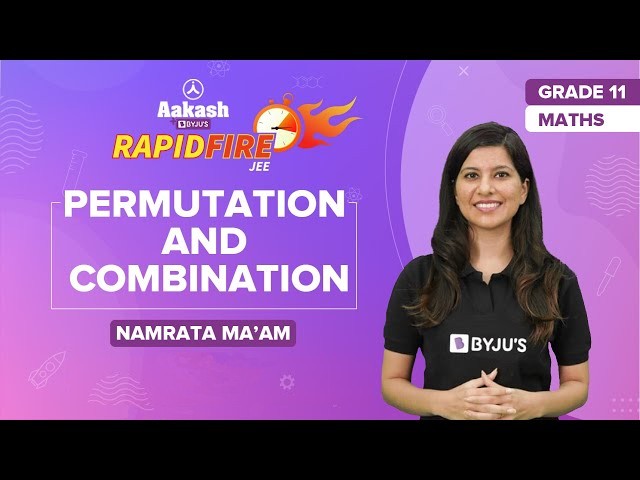
Permutations and Combination Problems and Solutions
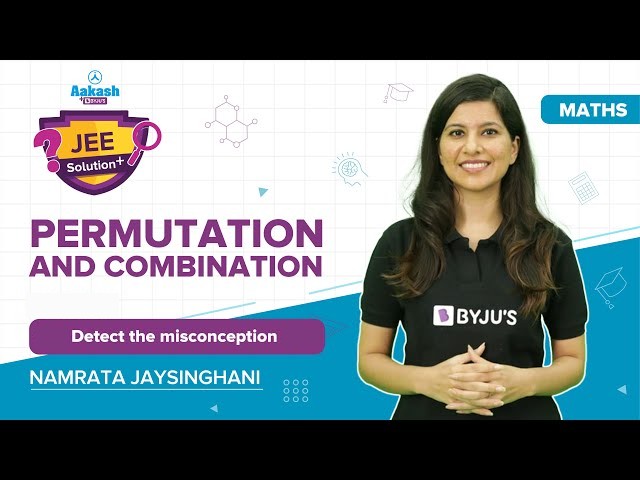
Problems Based on Permutations and Combinations
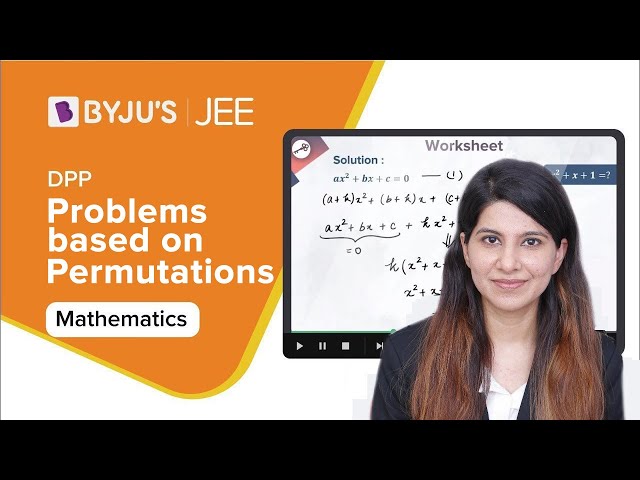
JEE Permutations and Combinations Solved Questions
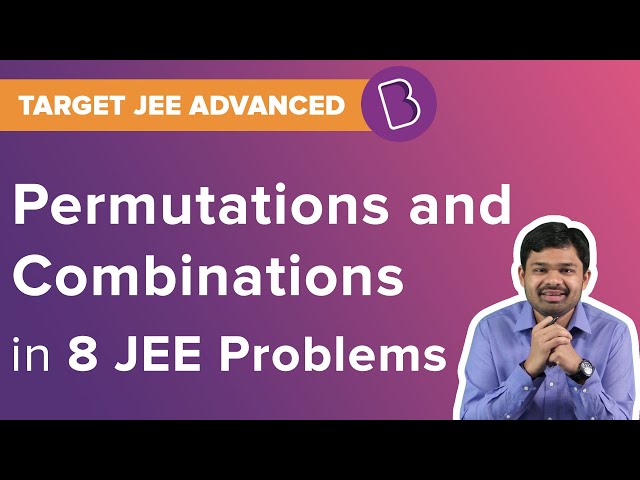
Permutations and Combinations – Bridge Course

Permutations and Combinations – Expected JEE Main Questions

Also Read:
Frequently Asked Questions
What do you mean by permutation and combination?
A permutation is a way of arranging the objects in order. Combinations are a way of selecting objects or numbers from a group of objects or collections, such that the order of the objects does not matter.
Give the formula for permutation and combination.
The formula for permutation is nPr = n!/(n-r)!. The formula for combination is nCr = n!/r!(n-r)!
Give the relation between permutation and combination.
We know nCr = n!/r!(n-r)!. nPr = n!/(n-r)!. So nCr = nPr/r! Or nPr = r! nCr.
What is zero factorial?
Zero factorial equals 1.

Comments